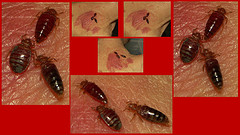
flic.kr/p/czgpqd
There are close to about a million species or kinds of insects thriving in our planet. There are millions more that had been extinct through the years because of natural phenomenon such as climate change and man-made environment changes.
But did you know that insects are the most resilient living organisms in the world? Unfortunately yes, it is true. They are so resilient that thousands of species can live for years without feeding or nourishment.
Scientists’ assertions and studies also note that if an annihilation do happen in the planet, every living creature will be affected and annihilated except for insects.
Insects are gifted with protective structures, generally in the outermost layer of their skin or physical structures. These protective layers, which are naturally and ordinarily characterized by wax-like substances, are what make insects very resilient and adoptive to harsh physical environmental changes.
In addition, insects have extremely low threshold to pain. Even if you crash an insect, or take out a wing, or handicap it, it would still try hard to move away from you or from any attacker.
Bed bugs
Bed bugs is only one among the millions, if not billions or trillions, of tiny insects living with us in this planet called Earth.
Bed bugs also belong to kingdom Insecta, which is scientifically known as Cimex lectularius.
Bed bugs are so small that you can hardly see them even in broad daylight. However, there are bed bugs that can grow to about one fourth of an inch, the most they can grow. These bed bugs are the mature ones that have regular source of food and good natural or conducive environment.
Like most other insects, bed bugs live in places that are usually neglected by people.
In your room, you can probably see and find bed bugs inside small and tiny crevices, holes or cracks in the wall, the ceiling, the floor, some furniture or even your bed.
Bed bugs are among those kinds of insects that hide or sleep during daytime to finally come out and hunt for food at night time. Call it smart, but such insects have amazing biological clocks that know when it is time to go out and hunt for prospective and unsuspicious victims.
Bed bugs’ food
We all know that bed bugs do not eat anything but blood. But the blood needed by bed bugs for nourishment should come from mammals, or hot-blooded animals. Again, they might be smart enough because they can tell by mere smelling if a prospective host or victim is hot-blooded or not.
Bed bugs suck on people’s blood. But their food requirement is not limited to blood of people. They can also suck, as alternatives, blood of cats, dogs, birds, or whatever animal or pet they can get their mouth into.
Bed bugs are among those insects that are provided with beaks that can pierce into victim’s skin. Such insects use those structures to suck and sip blood from their preys.
Insects usually are not carnivorous, so are bed bugs. But you may have a distinctive classification for them because of their eating habit. Well, somehow they can be related to vampires. Don’t be amazed -of course, that is just to tickle you with a little sense of humor.
Because bed bugs and similar insects prey on and eat blood, it follows that their excretion is also having similarity to blood. As they say, what goes in is what goes out!
For this reason, you can find that bed bugs’ craps and pee are red or deep-red colored. They may appear as such small red stains in your bed, your bed sheet, furniture surfaces or wherever they may have contact with.
Insects like that are usually detected because of their excretion. In some ways, these craps betray them.
Bed bugs and other insects
Because bed bugs belong to the insects’ family, of course, it follows that they are bonafide insects. Classifying them or grouping them with other blood-sucking insects will be logical.
However, be informed that, yes, bed bugs do suck blood, but they are still very safe. Not like mosquitoes, which transmit and transfer diseases form one person to another, bed bugs’ bites are not that notorious.
Scientists have found that bed bugs’ stomachs have linings and peptides that will not allow fungi, bacteria, and viruses to thrive. It may be a consolation for all of us!
Tagged with: bed bugs control • pests control
Filed under: Bed Bugs